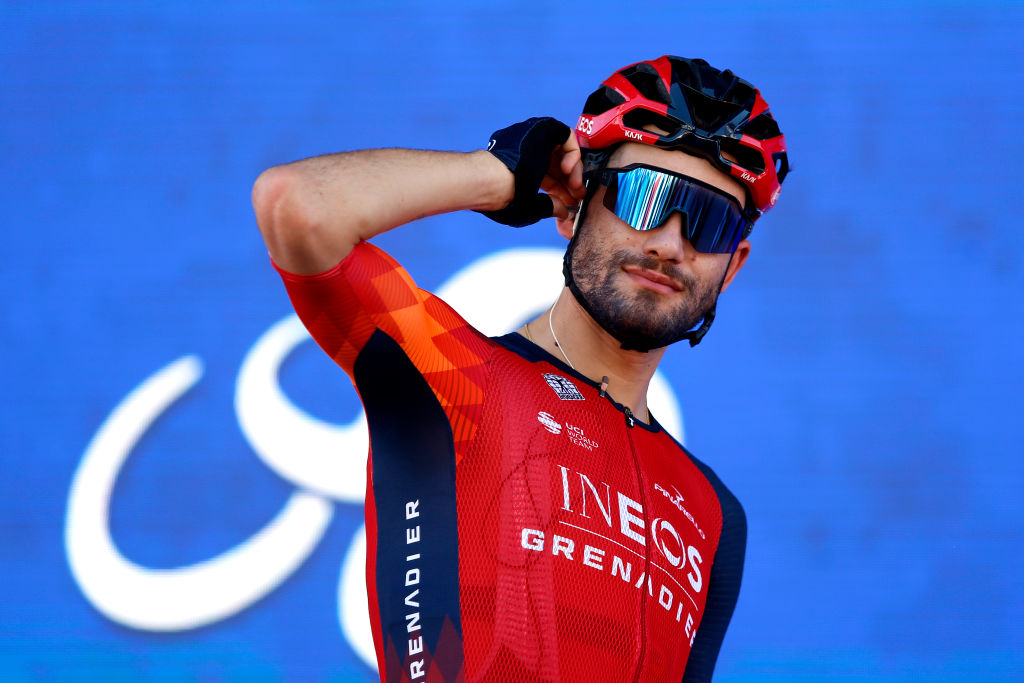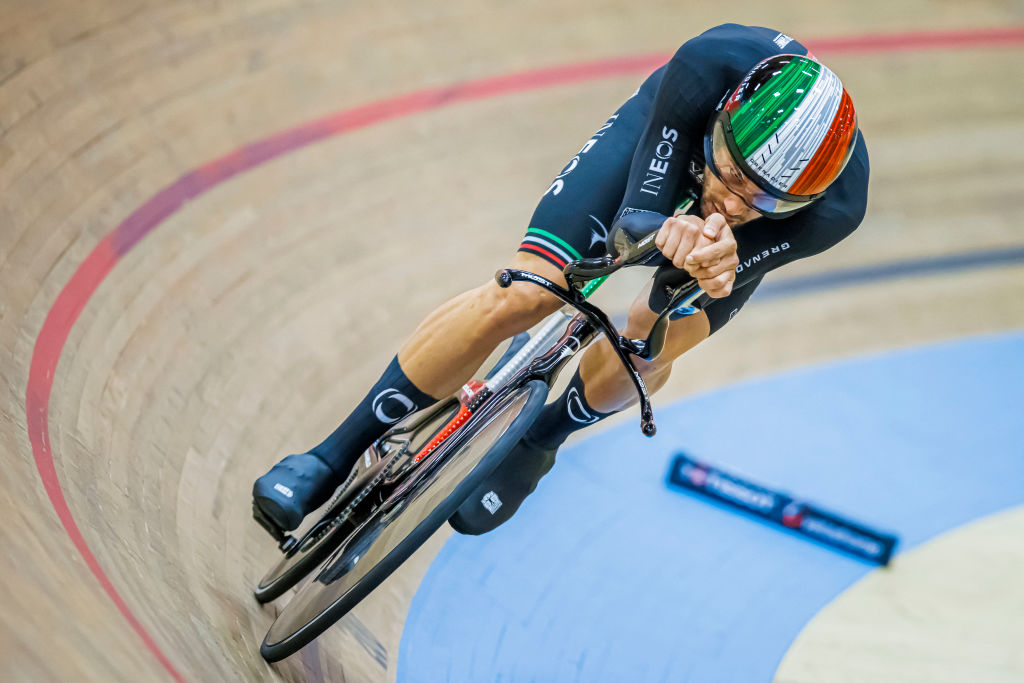Filippo Ganna: You can't love Paris-Roubaix, but it's the history of cycling
Hour Record holder toggles between track and road in 'intense' start to 2023

Last July, Filippo Ganna’s second life on the track briefly felt like a burden. His Tour de France debut had been more trying than anticipated. Fatigue, mental as much as physical, had mounted across the three weeks. The thought of tackling the Hour Record in August, as initially planned, only seemed to make things worse. A week from Paris, Ganna shelved the project.
“The plan was to finish the Tour and then immediately do the Hour Record,” Ganna says. “But when I didn’t have a perfect Tour like I wanted, I said it was better just to focus on finishing it. It was better to stay calm without thinking about the Hour Record or other goals. We decided to delay the attempt.”
At that point, Ganna would surely have been content to push any attempt into 2023, but the idea was never going to be allowed simply to wither on the vine. Ineos performance engineer Dan Bigham himself broke the record in August, which only heightened Pinarello’s desire to complete the harvest by having Ganna establish a new – and definitive – mark on their machine before new UCI regulations forced a redesign.
“Before the end of the season, Fausto Pinarello had studied the bike and prepared it, and he said, ‘Can we do something or not?’” Ganna says, breaking into a sheepish grin: “I said, ‘Ok, Fausto, I’ll try to do it.’”
Ganna’s displays on the road in the latter part of the season – third in the time trial at the European Championships, seventh at the Worlds – seemed to vindicate his decision not to tackle the Hour immediately after the Tour. By the time he returned to work on the boards, however, the velodrome had started to feel more like a refuge than an obligation.
Not for the first time, repeated laps of the track in Montichiari seemed to restart Ganna. Even before he travelled across the border to Grenchen for the Hour Record attempt, the mainspring was fully wound. “I think I got a good result,” he says with considerable understatement. His eventual 56.792km surpassed both Bigham’s record and Chris Boardman’s 1996 effort, set on the since-outlawed Superman position, and for good measure, he set an individual pursuit record of 3:59.636 a few days later at the Worlds in Paris.
Immediately afterwards, Ganna suggested he would never tackle the Hour again. In truth, his mark might have put the idea off anyone’s mind for years to come, even a man of seemingly boundless ambition like Remco Evenepoel. “If he wants to try, Grenchen is open for everyone,” Ganna laughs. “I’m not jealous.”
Get The Leadout Newsletter
The latest race content, interviews, features, reviews and expert buying guides, direct to your inbox!
This week, of course, Grenchen is open for the European Track Championships, where Ganna is, as ever, the star attraction. The quickest individual pursuiter of all time may also be the greatest, with five world titles to his name, though his finest moment came in the team pursuit when he powered Italy to gold at the Tokyo Olympics. This week marks the formal beginning of the countdown to their title defence at the Paris 2024 Games, and the first step was encouraging - on Wednesday afternoon, Ganna led Italy to the fastest time in qualifying.
“We’re back in this velodrome where I suffered a lot, the last fifteen minutes of the Hour Record were horrible, but I’m back, and we’ll try to do something to get points for the qualification for the Olympics,” says Ganna. The carousel never stops, but he wouldn’t have it any other way. Toggling between road and track, Ganna insists, is more a help than a hindrance, not least because the code-switching comes with the imprimatur of his Ineos team.
“They have a good relationship with the national team, they speak a lot, and it means we can do the perfect programme,” Ganna says. “I was able to tell Ineos I wanted to focus just for the Olympics in 2021, and they were happy for me to do what I wanted. I think we created a good atmosphere in both situations. It’s a good balance.”

Roubaix
Ganna is speaking at the Vuelta a San Juan, where he will start the year strongly with a fine second-place finish behind Miguel Ángel López. He knows that his 2023 season will be judged primarily on what he achieves on the road, and his performance in Argentina, which includes an assured display on Alto Colorado, was an encouraging portent. “To be honest, I came out of it much better than I thought,” Ganna would say afterwards.
His last podium finish in Argentina three years ago prefigured a break-out season on the road, capped by a victory in the time trial at the Imola Worlds and by four stage wins on the Giro d’Italia, including a solo effort on the rugged day Camigliatello Silano. With two time trials in the opening week of this year’s Giro, Ganna knows he will be expected to make a similar mark on the corsa rosa in 2023.
“I think everyone wants the Filippo of 2020, but it’s hard. Every year you try to improve your condition and yourself, but it’s not easy,” he says. “I want to try because the Giro, for me, is the most important race ever.”
Ganna’s view of the Giro is obscured for now, mind, by another mammoth event on his calendar. The relentless opening phase to his season is designed expressly for Ganna to build towards another tilt at Paris-Roubaix. “Algarve, altitude, Tirreno, San Remo, Classics,” he says of a programme where E3 Harelbeke, Gent-Wevelgem and Dwars door Vlaanderen will serve as the final tune-up for Roubaix. “No Flanders for me because I prefer to stay in Italy to train.”
Ganna won Paris-Roubaix as an under-23 in 2016, and though his first two attempts as a professional were underwhelming, he still lined up among the favourites for last year’s race. A bout of illness after Tirreno-Adriatico had hindered Ganna’s build-up, however, while a puncture cost him valuable momentum just as Ineos were breaking up the race. No matter, Ganna contributed what he could to Dylan van Baarle’s eventual win, and he was sufficiently encouraged by the experience to make Paris-Roubaix the centrepiece of his Spring this year.
“I learned that you have to save energy before the Arenberg and try to arrive there as fresh as possible, and it’s important to eat and drink a lot before the Arenberg because, after that, it’s left and right, left and right,” Ganna says. “But last year, my problem was that I spent a week in bed after Tirreno, and then I was chasing my shape. You need to arrive at 100% at the race because, at Paris-Roubaix, 50% of the riders are there to work for the leader, and the other 50% are leaders.”
Ganna’s gifts as a rouleur seem to make him the perfect prototype of a Paris-Roubaix winner, but transferring power from the smooth boards to the rough cobbled is never straightforward. The effort on pavé sectors may be similar in length to an individual pursuit, but any comparison between time trialling and the rigours of Paris-Roubaix has its limits.
“If you compare the Hour, for example, you stay at that range for sixty minutes,” Ganna said. “At Roubaix, on the other hand, you can recover a little in the bunch, but then on the cobbles, you ride really deep for five minutes. It’s really up and down efforts, and that’s different to my characteristics. But we’ll see.”
If Ganna’s presence in Grenchen this week owes much to his love for the discipline and his affection for the ambience within the Italian track set-up, his motivation for Paris-Roubaix is altogether different. The race, as he was reminded last year, is often cruel, and plans rarely survive their first contact with the cobbles. But then again, mixing some rough with the smooth is a part of the appeal.
“Yes, it’s a dream. But you can’t love Roubaix, because it’s like that,” Ganna says, banging his palm repeatedly off the coffee table in front of him. “No, you can’t love it. But it’s an amazing race, it’s the history of cycling.”

Barry Ryan was Head of Features at Cyclingnews. He has covered professional cycling since 2010, reporting from the Tour de France, Giro d’Italia and events from Argentina to Japan. His writing has appeared in The Independent, Procycling and Cycling Plus. He is the author of The Ascent: Sean Kelly, Stephen Roche and the Rise of Irish Cycling’s Golden Generation, published by Gill Books.